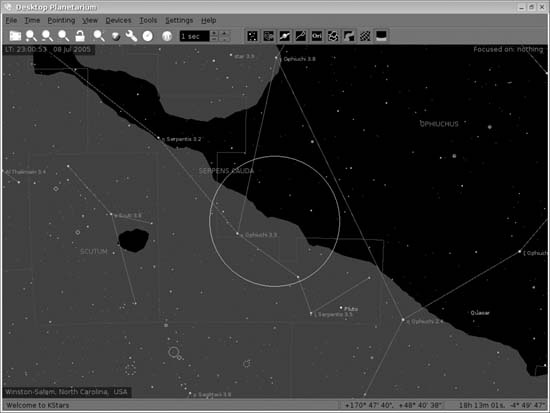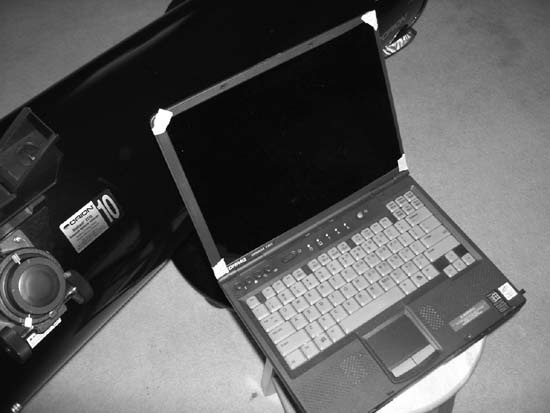Use your notebook while observing without damaging your night vision.
A notebook computer is an invaluable observing aid, but notebook displays produce enough light to destroy your night vision, not to mention that of everyone else in the vicinity [Hack #5]. Fortunately, it’s easy to modify your notebook to be suitable for observing sessions without making any permanent changes that would make it unsuitable for daytime use. Here are the changes we recommend.
- Dim the display
All notebook computers make some provision for adjusting the brightness of the display. The first step in dark adapting your notebook is to use these controls to set the notebook to the lowest possible screen brightness. Unfortunately, notebook computers are not designed with astronomers in mind, so the lowest available screen brightness is usually still much too bright.
Tip
Some notebooks, including the Compaq Armada E500 we use, allow you to change screen brightness by moving a physical slider or by using some combination of function keys. These models allow you to dim the screen whether you’re running Windows or Linux. Other notebooks require a Windows-only software utility to change screen brightness, so you may be out of luck if you’re running Linux. If your notebook is in the latter category and you’re running Linux, search the Web using the string <maker-name> <model-name> linux screen brightness or a similar search phrase. Linux-based screen brightness utilities are available for some popular notebook models.
- Use night-vision mode
All serious planetarium programs offer some form of night-vision mode. Figure 4-1 shows the night-vision mode of KStars. It is typical of the night-vision mode of most planetarium programs in that it uses a dim red color scheme for the main display, but leaves bright, colorful icons, title bars, and task bars visible. Just one of those items is enough to damage night vision noticeably, and all of them suffice to reduce your night vision severely. Night-vision mode is helpful, but used alone it is not nearly enough, even with your notebook display fully dimmed.
- Create an appropriate desktop theme
Standard desktop themes are bright and colorful, which is exactly what you don’t want in a notebook used for astronomy. Windows and Linux both include numerous standard themes, but none is optimized for astronomy. We suggest creating your own theme, limiting your palette to black and dark reds.
Tip
You can also use a free gamma-control utility such as Dark-Adapted (http://www.adpartnership.net) or NightMaster (http://www.ilangainc.com) to dim and adjust the colors of your notebook screen without changing your theme.
- Screen your display with red film
Covering your notebook screen with red plastic film eliminates nearly all of the actinic light that damages night vision and blocks the bright white light that leaks around the edges of most notebook displays. But not just any red plastic will do. You need something that is transparent, a deep ruby-red color, optically clear, stiff enough to mount and remove easily, thin enough to allow you to close the display, and robust enough to stand up to heavy use and dew.
We’ve tested various materials and found two that are suitable. Rubylith film is used by commercial printing companies and can be purchased in sheets of various size from most printing supply companies. (Avoid the similar Amberlith, which is an orangish color rather than the deep red of Rubylith.) Theatrical acetate gels are available in hundreds of colors, including deep red, and can be purchased in various sizes from theatrical supply companies and professional photography supply stores. Make sure to buy the transparent, clear version; theatrical gels are also available in frosted, translucent versions.
Figure 4-2 shows our Compaq Armada notebook computer set up for an observing session.
Rather than modify your primary notebook computer, we suggest you buy a used notebook and dedicate it to astronomy. You can buy a suitable used notebook on eBay for $500 or less, sometimes much less. Using a “disposable” notebook avoids exposing your expensive primary notebook to the risks of a typical observing session. In the dark, we’ve more than once come close to knocking our notebook off the chart table, and as often as not it’s literally dripping with dew when we pack it up at the end of a session.
Tip
If you do buy a used notebook, plan to spend an extra $50 to $100 or more to replace the battery. We’ve never yet seen a used notebook offered with a good battery.
Most planetarium programs have minimal hardware requirements and run acceptably on even slow older notebooks. For example, we used to run Cartes du Ciel under Windows 2000 on our Compaq Armada E500, which has only a Pentium III/700 processor and 256 MB of memory. We now have Xandros Linux installed on the Armada, which now runs KStars and XEphem [Hack #64] with no problems at all.
Get Astronomy Hacks now with the O’Reilly learning platform.
O’Reilly members experience books, live events, courses curated by job role, and more from O’Reilly and nearly 200 top publishers.



